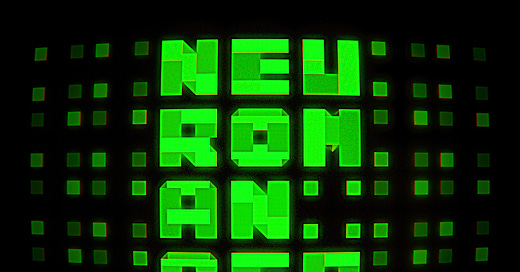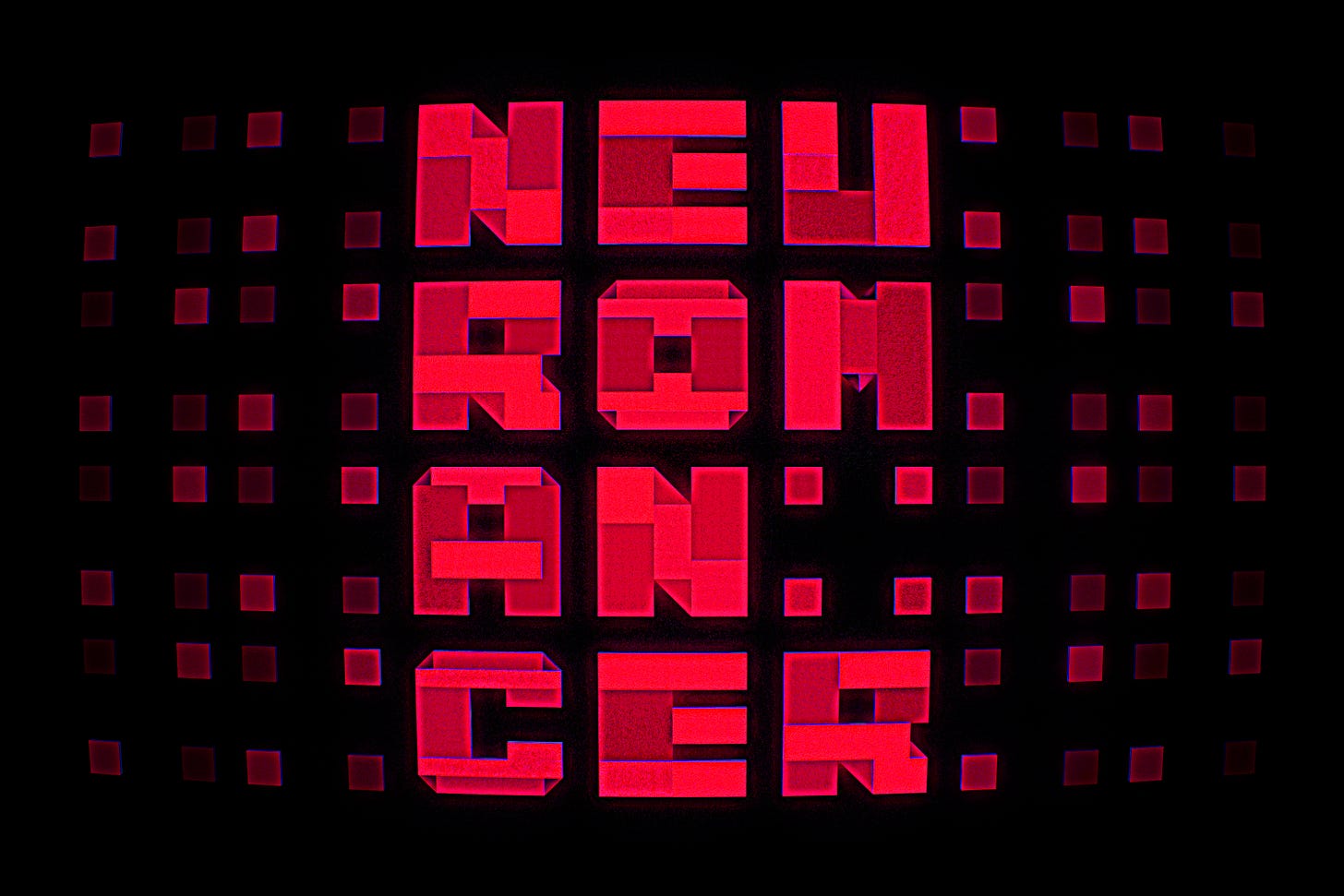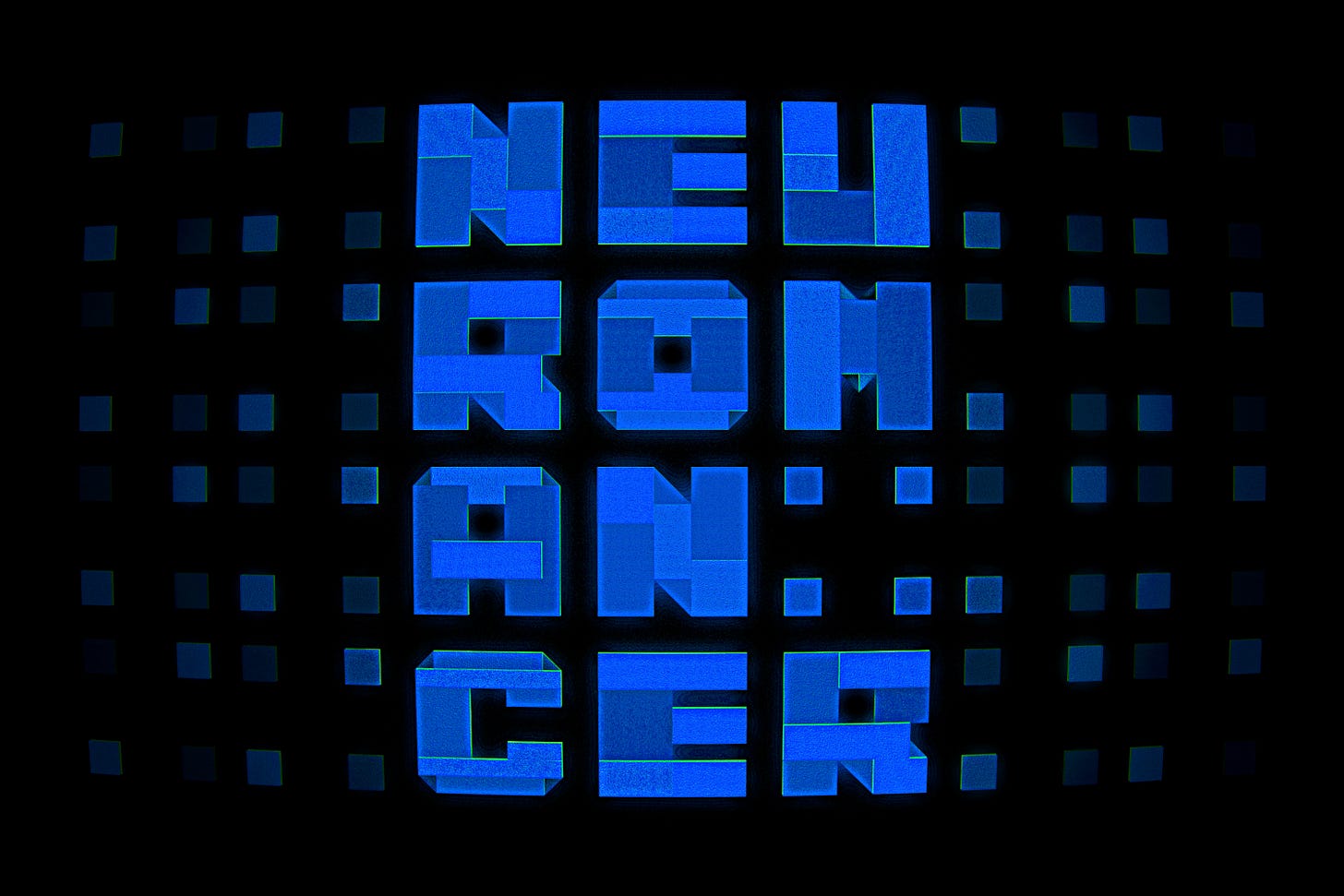Reading Neuromancer for the very first time in 2025
So many sci-fi movies, anime, and video games owe a massive debt of gratitude to William Gibson's seminal 1984 novel.
I have a confession: Until I started working at The Verge in 2016, I’d never heard of Neuromancer.
I was, of course, familiar with many of Neuromancer’s themes: Cyberpunk and cyberspace, computer hacking, corporate espionage, cybernetic enhancements, virtual reality, artificial intelligence, and near-future worlds populated with leather jacket-wearing murderous street punks. I just didn’t know how many of these modern science fiction tropes first appeared or became prominent in the pages of William Gibson’s book.
I recently decided to read it for the first time. My reasons were twofold: Firstly, I wanted to get my year of distraction off to a good start by avoiding as much social media as humanly possible. Secondly, I want to read a lot more hardback books, specifically science fiction hardback books, and have bought a series of titles to do just that: A Scanner Darkly, Do Androids Dream of Electric Sheep? and The Man in the High Castle, by Philip K.Dick; Roadside Picnic by Arkady & Boris Strugatsky; and The Foundation Trilogy by Isaac Asimov. But first and foremost on my list was Neuromancer. I read it in a week.
Read more from MBH4H:
Neuromancer IS cyberpunk. It’s a 3am neon-lit smoky dive bar cocktail of science fiction—a gritty, technology-fueled vision of a rain-soaked dystopian near future. For someone with even a passing knowledge of sci-fi from the last 40 years, it’s all astonishingly familiar even from the moment you read the opening line, “The sky above the port was the color of television tuned to a dead channel.”
Gibson isn’t the originator of the word cyberpunk—that honor goes to American author Bruce Bethke, who first used it for the title of his 1983 short story—and the word never once appears with the pages of Neuromancer. Yet Gibson’s novel has arguably shaped the entire cyberpunk genre more than any other book.
If you’ve never read Neuromancer, you still know Neuromancer—even if you don’t know that you know it.
Despite its relatively short length by modern sci-fi standards, Neuromancer isn’t an easy read. Gibson introduces a lexicon of technological terms that I found visually jarring and don’t always make immediate sense—especially when describing the characters’ experience of cyberspace. Gibson’s tendency to splice seemingly random words together to form new ones (like the now obvious “cyber” and “space”) or repurpose existing terms in new ways (“slivers of Microsoft”—to be sure, Gibson is not describing Excel here) meant I often had to reread paragraphs, pages, or even entire chapters to grasp what was happening, particularly early on. However, there may be a simple reason for this, and it has nothing to do with Gibson’s writing style.
Back in my Verge days, I often used Lorem Gibson in feature layout mockups instead of the standard placeholder text, Lorem Ipsum. It felt fittingly Verge-y—a cyberpunk twist on meaningless, abstract design filler. Even though I hadn’t actually read any of his work at the time, I loved how Gibson’s words, stripped of any context, created a flow of abstract, tech-laden phrases. When I finally sat down to read Neuromancer, I found that Gibson’s prose felt almost identical to the placeholder Lorem Gibson text I had used—so dense with jargon and terminology that my mind kept slipping off the sentences. Don’t believe me? Read this:
“Cowboys didn’t get into simstim, he thought, because it was basically a meat toy. He knew that the trodes he used and the little plastic tiara dangling from a simstim deck were basically the same, and that the cyberspace matrix was actually a drastic simplification of the human sensorium, at least in terms of presentation, but simstim itself struck him as a gratuitous multiplication of flesh input. The commercial stuff was edited, of course, so that if Tally Isham got a headache in the course of a segment, you didn’t feel it.”
To be clear, Neuromancer makes perfect sense—if you take your time with it. In my case, that also meant taking notes. Even the more abstract passages all come together when read carefully, such as descriptions of someone trying to bypass seemingly abstract shapes and structures as they attempt to pierce esoteric security measures in Cyberspace. Or the seemingly anachronistic, 2001-esque creature comforts found in the middle of a space station. But I’ll admit, it sometimes took me two or three tries to fully wrap my head around certain details.
Yet, it’s not just the language. The real challenge of reading Neuromancer for the first time in 2025 is that large swaths of the book feel so familiar precisely because it was so original in 1984. That originality has been absorbed, sampled, and remixed so much it has degraded, like a cassette mixtape copied too many times, across decades of sci-fi movies, TV series, anime, and video games. There are moments when the book reads like a greatest-hits collection of cyberpunk influences: The Matrix Trilogy, Ghost in the Shell, Elysium, Ready Player One, Strange Days, Alita: Battle Angel, Altered Carbon, Mr Robot, Black Mirror, Cowboy Bebop, and Cyberpunk 2077. Except Gibson did it first.
One name not on this list is Blade Runner. The 1982 film, directed by Ridley Scott and based loosely on Philip K. Dick’s Do Android’s Dream of Electric Sheep, predates Neuromancer by almost exactly two years. Gibson, who was about a third of the way through writing his novel when he first saw Blade Runner, later admitted he was convinced that readers would assume he had lifted its “visual texture” wholesale from the movie. It’s easy to see why. In 1984, Blade Runner’s visuals—thanks mainly to Douglas Trumbull’s special effects and Syd Mead’s iconic concept art—were gobsmackingly unforgettable. The film is so deeply etched into my memory that I can’t help but picture its dystopian, rain-soaked Los Angeles when reading Gibson’s descriptions of Chiba.
In many ways, Neuromancer has weathered the years better than Blade Runner. The movie, for all its brilliance, feels unsurprisingly dated at times. The once mind-blowing, building-sized digital billboards look decidedly meh in 2025. And it certainly doesn’t help that Blade Runner’s timeline is now part of our past—Roy Batty’s incept date was January 8, 2016, and the film’s events take place in 2019.
Ironically, just as Neuromancer was seen to draw heavily (albeit coincidentally) from Blade Runner in 1984, Denis Villeneuve’s Blade Runner 2049 from 2017 seems to return the favor by sharing a few parallels with Neuromancer: The prevalence of holograms, the deep ethical questions about artificial intelligence and its right to self-determination against corporate control, and the general cyberpunk vibe mean I think it’s time we call it quits on this.
(To be fair, some of Blade Runner’s dated feeling may have to do with its “visual texture” being so well defined by Scott’s film—despite the many works it has inspired, Neuromancer has yet to have its own adaptation. It’s going to be very interesting to see how Neuromancer is visualized in the upcoming series on Apple TV+. Only then will we be able to compare, excuse the pun, apples with apples.)
None of this is to say that Blade Runner is no longer an iconic movie—it’s still one of the greatest science fiction films of all time. But Neuromancer, despite being so deeply woven into modern sci-fi culture, still reads as startlingly fresh and relevant: Artificial intelligence, and virtual reality are now nascent technologies. Even cybernetic enhancements don’t seem that far-fetched anymore.
Reading Neuromancer for the first time in 2025, I was struck by how eerily prescient Gibson was in so many ways—but also by what he didn’t anticipate. You can still smoke in a bar, for one. Also, print media is still the norm (maybe it makes a comeback?), and discarded newspapers blow through the streets of Manhattan. Most noticeably, not a single person in the book uses a mobile phone. There are levitating trains but no cellular devices—at one point, the main character is stalked by the ringing of payphones (very Matrix).
But what stands out most of all is that the vast amount of technology described in Neuromancer is either Japanese or German. The Standard Hitachi Pocket Computer, the Sanyo Vacuum Suit, and the Ono-Sendai Cyberspace 7 from Hosaka Computer? All Japanese. The Braun Coffee Maker, the Braun Microdrone, and the Telefunken Entertainment Console? All German. Not one piece of American tech I can think of is mentioned. Even one of the spacecraft is built by the Dornier-Fujitsu yards, a fictional German-Japanese manufacturer.
Which should hardly be surprising. In 1984, the future of technology looked distinctly non-American: Japan was dominating consumer electronics (think: Sony Walkmans and Pioneer Laserdisk players). The only Microsoft products were software and a mouse; Apple had only just released the first Macintosh. Gibson’s assumption that all of the state of art technology in the future would be Japanese makes all the sense in the world.
‘People tend to vastly overestimate what will happen in 50 years and massively underestimate what will happen in the next two.’
Back in 2013, I interviewed a futurist who was being a little less than forthcoming on camera. So I asked him a deliberately stupid question, one that might annoy him just enough to elicit an interesting response: “What will the future be like in 50 years?” He looked at me like I was an idiot and said something along the lines of, “How on earth can anyone predict with any degree of certainty what the world will be like in 50 years' time.” And then he said something that stuck with me ever since: “People tend to vastly overestimate what will happen in 50 years and massively underestimate what will happen in the next two.”
Neuromancer has become more than just an influential novel; it’s now the blueprint for the entire Cyberpunk genre. Even if you’ve never read it, you’ve felt its impact in nearly every major sci-fi film, TV show, anime, and video game of the past 40 years. Gibson didn’t invent cyberpunk, but he defined it. He created the lexicon—cyberspace, matrix, sprawl—that shaped how we imagine our digital future.
The exact timeline of Neuromancer is never specified. Gibson smartly avoids the Blade Runner incept date trap. Yet, aside from a few outliers here and there, the book feels like the near future, which makes reading it for the first time in 2025 both revelatory and slightly disorienting.
On one hand, Neuromancer feels shockingly prescient and relevant. Gibson’s ideas about artificial intelligence are downright uncanny when considering when the book was written. The same goes for virtual reality, though I’m not sure I want Meta Ray-Bans permanently wired to my face. On the other hand, some of the book’s omissions (cell phones and the lack thereof) and assumptions (massive space stations with atmosphere, beaches, and nightclubs) highlight just how difficult it is to extrapolate current technological trends accurately into the future, even for a visionary like Gibson.
Take, again, Neuromancer's very first line: “The sky above the port was the color of television, tuned to a dead channel.”
I’m not as old as William Gibson. But I’m old enough to remember when changing the channel on a black-and-white TV meant using the dial to scroll through static-filled “dead channels.” But even by 1984, dead channels were a thing of the past: 24-hour news had been around since 1980, and MTV had been alive and kicking since 1981. Gibson later admitted in an introduction to the book, “It took at least a decade for me to realize that many of my readers, even in 1984, could never have experienced Neuromancer’s opening line as I’d intended them to.”
But in the end, none of that really matters. Science fiction shouldn't be about accurately predicting future technology; it's a narrative through which we focus on better understanding the human condition, free from the distraction of our current reality. And if that’s the goal, Neuromancer is as relevant today as it was in 1984, if not more so.
Neuromancer in hardback:
I missed out on the beautiful limited edition of Neuromancer from The Folio Society (it sold out in four hours!), but fortunately, they've introduced a non-limited version featuring the same gorgeous artwork by Anna Mill, and yes, of course, I bought it. (This is not an affiliate link; we're simply sharing it because we love the book.) —James Bareham
Update: This essay has been edited to clarify that Douglas Trumbull was the Visual Effects Supervisor on Blade Runner, not the cinematographer. Jordan Cronenweth was the cinematographer.








I read it for the first time this year too! Really enjoyed it and I hope it doesn't get butchered in the series.
Between it and Snow Crash... so much of what VC has been spent on.
It’s interesting to consider what makes a story age. Before reading Treasure Island, I expected it to feel so dated, but IMHO, it’s a great read—even 142 years after its release. It also defined a genre and inspired many similar works, yet still felt fresh to me. Anyway, I love both stories. Could Gibson have created a sci-fi novel that aged even better?